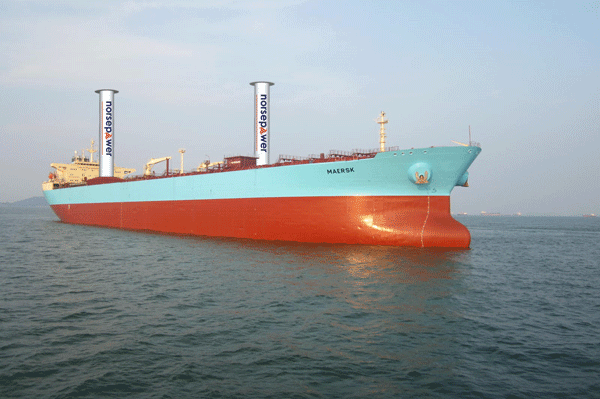
Maersk Tankers to harness the wind

Maersk P class illustration with two 30x5 Norsepower rotor sails
The first installation of rotor sails on a working products tanker has been agreed between vessel owner Maersk Tankers, Norsepower and Shell, and the project is being majority-funded by the UK’s Energy Technologies Institute (ETI).
Two 30m-tall Flettner-type rotor sails with a diameter of 5m will be installed on board the LR2 tanker during the first half of 2018 and the vessel’s subsequent performance, notably in fuel and emissions savings, will be monitored and analysed until the end of 2019 while it continues routine operations. The two rotor sails are expected to reduce average fuel consumption on typical global shipping routes by 7-10%. Shell will act as project coordinator.
Maersk Tankers’ chief technical officer Tommy Thomassen explained: “Together with our partners, we have the opportunity to deploy an innovative technology that can improve fuel efficiency on our LR2 product tanker vessels and help to reduce their environmental impact. We look forward to contributing to the project, and sharing our decades of experience and knowledge within safety and tanker operations.”
Tuomas Riski, Norsepower CEO, said that the company was “privileged and excited” to be working with Maersk Tankers, Shell and the ETI on the project. “We are optimistic that support for this trial from these industry-leading organisations will open up the market for our technology to a larger number of long-range product tanker vessels. As an abundant and free renewable energy, wind power has a role to play in supporting the shipping industry to reduce its fuel consumption and meet impending carbon reduction targets,” he added.
Norsepower’s Rotor Sails are a modern version of the Flettner rotor, a spinning cylinder that uses the Magnus effect to harness wind power to supplement a ship’s own power. It is thought likely to be particularly suitable for tankers and bulk carriers, with fuel-saving benefits possibly reaching double digits.
